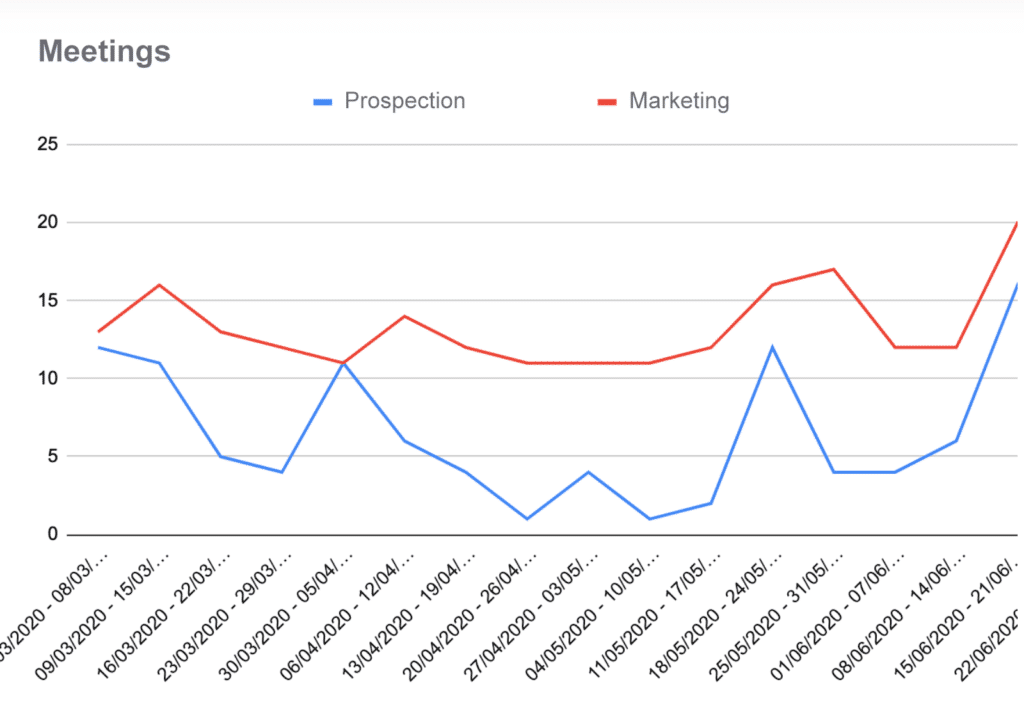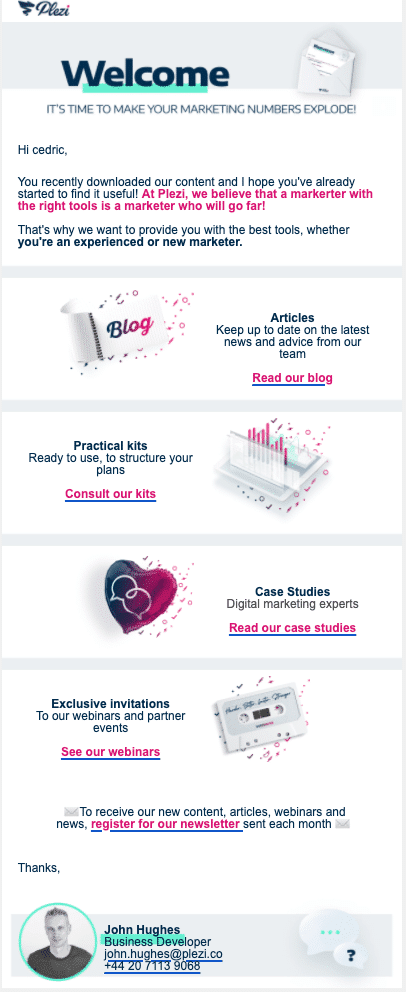With lockdown now over and a return to (almost) business as usual, we wanted to take some time to assess the developments and lessons learned during this challenging period. For us, the impact was significant. We asked ourselves a lot of questions about strategic issues and the actions we needed to put in place. But we were sure of one thing, and this has been confirmed by results that we can now share with you: digital marketing has been key to our performance during this public health crisis, and almost certainly to yours as well!

In this article you’ll find:
- Our assessment of lockdown
- The specific ways in which digital marketing helped us
- How our digital marketing strategy provides us with insight into the future
1. From shock to learning to adapt: our assessment of lockdown
This period wasn’t just highly unusual for us; virtually all companies were hit hard by this public health crisis. Like many, however, we started to turn the corner when we implemented actions designed to get back on course and as companies adapted to the situation.
1.1 Two rather different impacts: marketing and sales not (quite) in the same boat
Marketing: we didn’t react hastily, and trends started returning to normal in the second week
Like many B2B companies, the announcement of lockdown set alarm bells ringing for our marketing and sales teams.
A widespread reduction in traffic to the website, prospects who were suddenly unavailable, a fall in the number of prospecting appointments… Everyone’s focus was on their immediate response to the crisis – including us! We had to think about immediate technical and practical issues, along with a whole lot more.
Thankfully, we didn’t act too hastily. Our marketing figures (e.g. traffic, lead generation) started to trend upwards again during the second week of lockdown. Our in-house marketing team was working from home, and the nervousness among our prospects caused by initial announcements started to calm down. Everyone started to settle into the rhythm of the lockdown.
Sales: prospecting was difficult with a significant fall in the number of appointments
The slowdown was particularly difficult for our salespeople, both in terms of results and the morale of the sales team.
The first week was especially difficult for our inside sales team (who are the first link in our sales chain). On the front line, they listened to our prospects’ concerns and did their best to answer their many questions.
Although we quickly implemented a number of actions to support and motivate them, for more than 2 months our salespeople found themselves faced with two obstacles that were difficult to overcome:
- prospects, who were furloughed or working from home, were very difficult (if not almost impossible) to reach;
- those who could be contacted didn’t feel they were able to make strategic decisions (e.g. make appointments, allocate budgets) and pushed out the time frames of projects.
Result: the number of appointments made was directly affected. Prospecting appointments came to a virtual standstill and we were a long way from meeting our targets.

2. Inbound marketing, a solid foundation to cushion the impact and get back up and running
What kept us going during this period was the constant flow of leads from marketing efforts. Even though we also experienced a drop in the number of appointments made via this channel, this trend quickly stabilized.
This resulted in a drop in the rate at which marketing qualified leads (MQL) were converted into sales qualified leads (SQL): our prospects were simply too difficult to get hold of.
However, once working from home and back online, our prospects were open to having a conversation and often very interested in learning more.
The conversion rates of our sales team, initially stable during March and April, started taking off from May: up by 50% in May and by more than 60% in June! Plezi’s lead generating machine kept running, and our prospects found they finally had time to focus on some long term issues.
The marketers we talked to during this period, also found themselves with more time to finally start addressing their larger issues.
Executives, interested in the opportunities that digital marketing can provide, realized that marketing wasn’t simply a cost centre: digital marketing was quickly becoming a priority for their business.
I had a call with a prospect which went very well. We said that we would touch base again in June, but she was the one that contacted me, and much earlier than expected. She told me that her executive team recognized the need to move forward quickly with regards to inbound and digital marketing. She had their support and a budget at her disposal to spend. Arnaud, Inside Sales
So, while initially it didn’t seem like great timing, we were able to get things rolling with prospects who were motivated and who had both the support of management and the time.
2. How did we do it? Answer: digital marketing and the tangible support it provides!
We’ve been able to cushion the impact of the crisis and keep our figures stable by using an inbound marketing strategy and marketing automation implemented using Plezi. With this solid foundation, we’ve been able to confidently initiate new processes aimed at generating results.
2.1 Long-term choices and investments that pay dividends
A clear and adaptable content strategy
During lockdown, our prospects spent more time on gathering business intelligence: yes, they had more time to do so, but they were also increasingly aware that they needed to implement new solutions if they wanted to continue to generate leads!
During this period, the real benefits of inbound marketing were clear: rather than exhausting ourselves looking for prospects that were difficult to contact, they were the ones who came to us! Our blog posts enabled us to continue to generate traffic to our website and our downloadable content (e.g. kits, white papers, and webinars) meant that we converted these visitors into prospects and then into qualified prospects.
Below, you can see the drop in traffic during the first week of the lockdown, before the figures start to rise again in the following weeks.

- educate themselves about marketing, specifically inbound marketing and new marketing methods;
- identify new opportunities for their business and explore possible solutions;
- return to more “long-term” issues they had set aside, like a switch to inbound marketing and redesigning their content strategy.
From the very beginning, we’ve focused on educational content to help our prospects increase their proficiency in inbound marketing, and this tactic has really paid off!
Our practical kits and webinars targeted at the problems faced by companies during lockdown enabled us to have conversations with prospects that were not yet at the purchase stage, but who had a lot of questions about marketing automation.
SEO/SEA: a long-term bet
Since we first implemented a digital marketing strategy at Plezi, we’ve been convinced that we needed to focus on SEO and not rely solely on paid channels like SEA.
As our growth marketer, Benoit, often says, the difference between SEO and SEA is a lot like renting VS buying: renting a flat provides you with an immediate result, but when the rent stops being paid, you find yourself out on the street. Buying requires more of an initial investment, but it ends up paying off in the long run.
And our investment certainly paid off during lockdown. During this period, the cost-per-click of Google Ads soared as a result of the volatility of SEA: many companies, wanting to ensure a good position on a search engine results page, increased their investments in paid channels, which in turn drove up costs.
SEO, on the other hand, has been a reliable source of leads. The content and keywords we have focused on normally provide us with a steady increase in website traffic and numbers of leads.
During lockdown, we saw a 40% increase in leads generated through SEO, which offset the drop in leads from our other acquisition channels (prospecting and events).
There have also been other benefits from this investment: the acquisition cost of leads via SEO was lower than that of SEA and this was also the channel that generated the most customers with the best conversion rate.

As a result of soaring SEA costs, lead generation has been more expensive. We’ve primarily been able to generate so many hot leads (MQL) because we’ve implemented a lead nurturing strategy.
Nurturing actions, like our automated newsletter, smart campaigns, and targeted workflows have enabled us to keep passing leads to salespeople every week, despite a drop in the number of leads in the first week of lockdown.
We decided a while ago to move from a “create as much as possible” content strategy to a more qualitative approach.
Our content, which is better thought-out and better presented, provides real value to our prospects. This approach has definitely worked and helped us to convert these prospects into marketing leads.
And we’re not alone: a large number of B2B companies have seen a clear increase in the number of leads from marketing via their website.
Unable to make use of their two most important acquisition channels (events and cold calls), Deepki has been able to stay on course by using inbound marketing. Despite the challenges posed by lockdown, they managed to maintain customer relationships and generate leads.
Companies that use an inbound marketing strategy, even one that is modest in scope, saw their results improve: the various actions we put in place helped boost both traffic to our website and generate 20.44% more leads.
2.2. New approaches to nurture our customers, engage prospects, and continue to generate results
An even greater focus on our customers
Above all, our content strategy has worked because our content manager has listened carefully to our prospects and customers.
During lockdown, this approach proved highly beneficial. We took the opportunity to:
- listen to the calls our salespeople and CSM have had with prospects to better understand their concerns and guide our creation of content accordingly;
- interact with our customers and work with them on a number of case studies to showcase our work together.
Our customers were more than willing to share their feedback when inbound marketing had allowed them to continue to generate leads, despite the health crisis.
Wildly successful webinars
The star content performer during lockdown has been the webinar. Like us, a large number of companies have pounced on this opportunity to engage customers and have seen very good results from them. One of our customers, Lemonway, made use of the lockdown to test webinars and they’ve been highly successful:
“We started doing webinars because we wanted to experiment with some different content formats. Both our prospects and customers have been very receptive, and we’re really surprised at how fast our numbers are going up! This type of content works really well for us.”
We were initially worried that they might end up covering a lot of the same ground, and that prospects might start to lose interest after the first few weeks. But in the end, the results were rather positive. Thankfully it wasn’t all too much for you! On the contrary, our sign-up and participation rates took off. The attendance rate of our webinars grew from 40% in March to more than 60% in May!
To continue to reach our prospects, we focused on providing advice and sharing our experience. By setting aside a focus on sales, our participation rates increased, and this led to increased trust from prospects. Indeed, they often came back to attend several webinars in a row!
Social networks: trying out new things rather than following the herd
During lockdown, our B2B prospects were much more active on social networks, in particular on Linkedin.
To try and stand out from the crowd, we created posts that were different from those we would normally do or from what we could see others doing. We took the opportunity to try out new post formats and to further improve our brand image using gifs, videos and slideshows.
Result: a rather impressive increase in our engagement rates (up 105.49%) in March and April, followed by an increase in the number of leads in April and May.
We also introduced some new email formats that linked to our social networks to maximize engagement.
3. A machine that’s already working and helping us for the future
Our inbound marketing strategy and the actions we’ve implemented in response to this health crisis have enabled us to both cushion the impact of lockdown and meant that our figures are again trending upwards.
Like many companies, we normally see the year fly by and end up putting off a number of projects due to a lack of time. In marketing, let’s not even go into it! We’ve got a list of projects we want to get started on as long as your arm, but rarely have the time to do so.
So, we used this period to do some housekeeping regarding some of the major issues we’ve been thinking about for a while:
- Data: we’ve cleaned out contact database and enhanced it with automation to ensure better leads for our salespeople;
- Nurturing: we’ve reviewed our nurturing actions by removing old content, creating new content, and by classifying existing content,
- Scenarios: We’ve reworked our scenarios and implemented new ones, like our workflow used to welcome new prospects and to start a conversation with them.
These major projects will not only be useful going forward, they also give us a good foundation to get back to business as usual, more motivated than ever.
We’re relaxed about what the future holds, because this period has proved several things to us:
- we’ve already got everything we need (and put in place all the actions) to generate qualified leads for our sales team;
- we have many prospects and customers convinced of the advantages of inbound marketing and keen to implement new ways to generate qualified leads;
- we’re also convinced that digital marketing is key to companies’ performance in a crisis like the one we’ve just faced. Our experience is the proof of that!
What was your experience of lockdown? Have you put in place new processes as a result, or are you hoping to do so? Why not get in touch so we can talk about it together?







